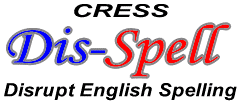Here are the links to the Youtube and the podcast. A transcript of the content follows:
Youtube:
Podcast: Audio Player
Here is a transcript of the content:
SSSS versus CRESSS
Using the Simple Alphabet for Any Sound
A Fundamental Contrast
SSSS: Senseless Spelling Sabotaging Society: the existing system of traditional English spelling makes no sens.
In this one page we show how to write any word simply, consistently, without confusion in a perfectly regular fashion:
In CRESS, most of the English letters are used the same basic way as in traditional English
- There is nothing different to learn
- These letters transfer from traditional English to CRESS
- p b t d k g (as in go)
- f v s z h
- m n
- y w
- Some are not even necessary:
- c j q x
CRESS has no confusing digraphs to worry about: a sound is a letter and a letter is a sound
- no ph for f as in ph phone
- no ti for sh as in ti ignition
- no ea as in read versus read, lead versus lead
- no oo as in foot versus food, good versus mood
- Etc.
CRESS is built on linguistic science
- The alphabet provides basic positions
- Imagine X-Ray of a speaker from the LEFT side
- Think about the tongue point of pronunciation
Vowels are written similar to, and transparent to, Traditional English
- i = tongue is high front
- e = tongue is low front
- u= tongue is high back
- o= tongue is low back
- a= tongue is low center
But there are more sounds!
- These are just adjustments to the basic sounds… close neighbors
- Here are some neighbor vowels:
- i = bit, but what about beet: The tongue is raised a bit so add an up arrow ^ = i^
- u = look, but what about Luke: The tongue is raised a bit so add an up arrow ^ = u^
- e = bet , but what about bait: The tongue is raised a bit so add an up arrow ^ = e^
- o = or, but what about boat: The tongue is raised a bit so add an up arrow ^ = o^
- a = pot, but what about putt: The tongue is raised a bit so add an up arrow ^ = a^
- So very simple…
- Just add up arrow ^ after any neighbor sound that raises the tongue!
- Advanced Note: all vowel arrows can be streamlined in advanced use
- Using h or double letters
- This is not advisable for initial learning of the phonetic principle and phonemic awareness
And if the neighbor sound is fronted just add <
- a = pot, but what about pat: The tongue is fronted a bit so add a front arrow < = a<
This adheres to science and is consistent with simple practical adjustments.
- In learning to read and write, phonetic basics and the phonemic principle are built in.
- No more worry about phonemic awareness in reading theory.
Consonants have neighbors too.
- The same system handles them… consistency!
- s = sin, but what about thin: The tongue tip is fronted to the teeth so add a front arrow < = s<
- z = zen, but what about then: The tongue tip is fronted to the teeth so add a front arrow < = z<
- s = sin, but what about shin: The tongue tip is pulled back a bit so add a back arrow > = s>
- z = ruse, but what about rouge: The tongue tip is pulled back a bit so add a back arrow > = z>
- n = sin, but what about sing: The tongue back is used in in place of the tip so add a back arrow > = n>
- Note: These arrows also can be streamlined for advance use but not where the phonetic/phonemic principle is being learned
A Few Sounds Combine Two Simple Pronunciations
- The first sound in chin has two parts: ts>
- The first sound in gin has two parts: dz>
- These could be written as c for ts> and j for dz> if CRESS is streamlined
Three vowel combinations are easily handle:
- The tongue glides from a to i in my = ai
- The tongue glides from o to i in boy = oi
- The tongue glides from a to u in out = au
Summary:
- The simple basic system and simple subsystems are easy to learn
- They make sense
- They are regular and consistent
- They have no negative or wasteful or discouraging learning effects
